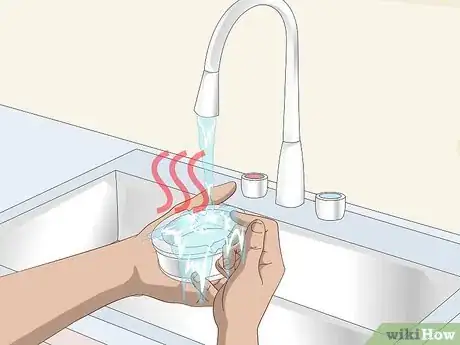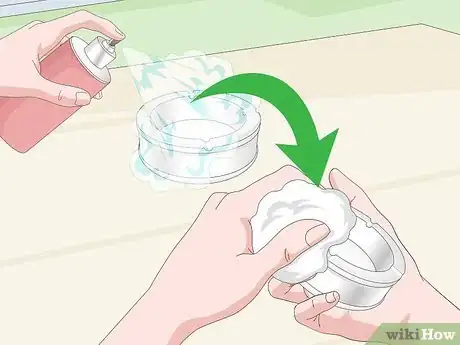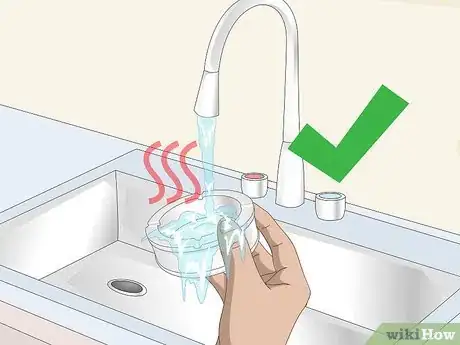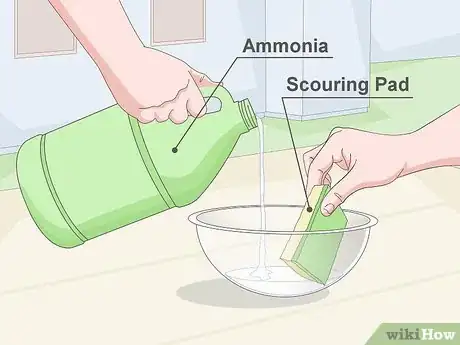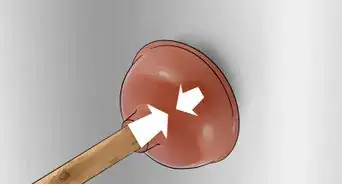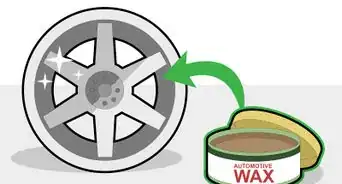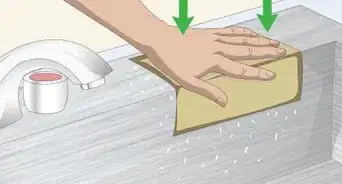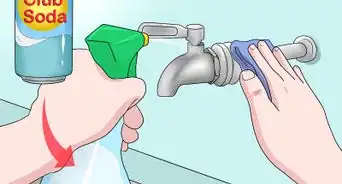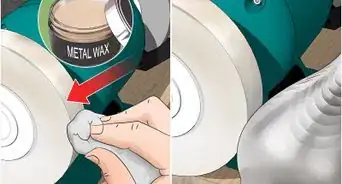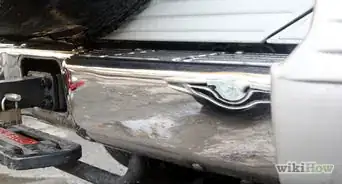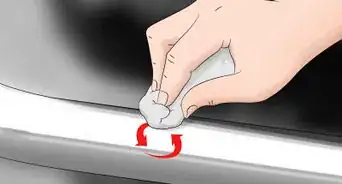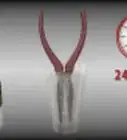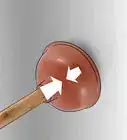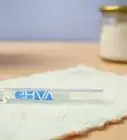This article was co-authored by wikiHow Staff. Our trained team of editors and researchers validate articles for accuracy and comprehensiveness. wikiHow's Content Management Team carefully monitors the work from our editorial staff to ensure that each article is backed by trusted research and meets our high quality standards.
There are 7 references cited in this article, which can be found at the bottom of the page.
This article has been viewed 300,627 times.
Learn more...
Nickel plating is used to provide resistant decorative coatings to metal. It is used on many industrial parts, but it can also be found on many household items like grills, door hinges, or faucets. When grease stains and tarnish begin begin to appear, you’ll need to clean off your plating. By washing first with warm water, using a metal cleaner for persistent blemishes, and then polishing, you will keep your nickel plating strong and lustrous for years to come.
Steps
Cleaning with Water
-
1Polish the nickel with a soft cloth. Before trying anything else, see how much grime you can clean by wiping it away. Many grease spots, smudges, and patches of grime can be buffed away with cloth and a little bit of warm, running water. Use a soft, non-abrasive cloth and rub down the nickel plating, applying extra pressure and attention to dirtied areas. Use small, circular motions to buff away the grime.[1]
-
2Prepare a solution of soapy water. Cleaning with soap and water is always gentler than using acid and should be tried first. Choose a mild dishwashing detergent. Fill a container full of warm water and add the detergent until the water appears soapy. Hot water, cold water, and abrasive soap will all damage the plating.Advertisement
-
3Wash the nickel plating. The way you do this up to you and the supply of soapy water you have. Small objects can be washed in or near a container of soapy water. For larger objects such as nickel-plated stoves or immobile objects such as shower heads, take a soft cloth, dip it in the water, and use that to buff out the stains.[2]
- Avoid using harsh scrubbers as much as possible, as they damage nickel plating.
-
4Rinse off the soap. Run the plated object under running warm water. For larger, immobile objects, gather more clean water. Pour the water on the area or use a soft, clean cloth dipped in water to remove the soap.
- Try doing this once a year to keep the staining and stress on the nickel plating to a minimum.
-
5Dry it off. Take a clean, soft cloth. Pass it over the wet areas. Make sure you remove all the water so it doesn’t seep into the nickel. This also gives you a chance to check for any remaining soap that needs to be removed. Keep working with the cloth until the plating is dry.
Using Bottled Cleaners
-
1Polish with metal polish. When your nickel plating isn’t dirty enough to warrant harsher cleaning methods, apply a non-abrasive metal polish. Chrome polish works well on nickel plating. Apply a small amount of the polish to the plating, then wipe the surface in circular motions as you did while cleaning.[3]
- Alternatively, you can try this step after using other cleaning methods in order to make your nickel plating shine.
-
2Apply a metal cleaner on discolorations. Find a non-abrasive metal cleaner at the store. Chrome cleaner works well on nickel plating. Apply the cleaner directly to the stained areas, particularly the green discolorations that build up on nickel with ease. Let it sit for a minute.[4]
- WD40, which penetrates oil, can also be used.
- Oven cleaners are another option and are useful for removing grease.
- You may wish to test this method on a small spot not readily visible. If the plating is especially thin, the steel wool or scrubber will cause damage.
-
3Scrub the plating. After applying the bottled cleaner, try using a cloth first spread it over the plating. You can also use steel wool or a soft scouring pad on stubborn stains and discolorations. Use small, circular motions to work in the cleaner. Be as gentle as possible to avoid causing scratches to the metal.
Cleaning with Vinegar
-
1Prepare a vinegar cloth. Vinegar is a mild acid that has great effect on stains. Pour a small quantity of vinegar into a bowl. Soak a clean, soft cloth in the vinegar. Wring out the excess.
-
2Scrub the dirty areas. Apply the vinegar cloth and gently attempt to buff out the stains. Move the cloth in circular motions with a gentle touch to avoid stressing the nickel as much as possible. Re-soak the cloth as needed.
-
3Make a solution of vinegar and water. For stubborn stains, you may need to soak the nickel plating. Combine four parts water with one part vinegar in a container that will either contain the nickel piece or hold enough solution to put on the stains.[5]
- Do not use straight vinegar. It is often too abrasive to expose to thin nickel coatings for extended periods.
- Nickel plating is easily damaged by acid, so vinegar cleaning should be done sparingly on stubborn stains.
- You can heat up your mixture to give it a little more cleaning power if you desire. This should only be done if the object won’t be soaked in it.
-
4Soak the nickel in the solution. Soak the nickel-plated item in the solution for several hours. The stains should have begun to lift. Alternatively, pour the vinegar solution over the object and let it rest for 30 minutes. Repeat as necessary.
-
5Rinse the plating. Use warm running water or apply a soft cloth dampened in water. Make sure all the vinegar is gone. Vinegar left on the plating will continue to wear away at it. Wipe with a second cloth if necessary to make sure it is all gone.
Applying Ammonia
-
1Prepare an ammonia pad. Ammonia, like vinegar, is effective on stains. Pour a small amount of pure household ammonia into a bowl. Drip a scouring pad or rag into it.
-
2Scrub the dirty areas. Apply your pad or rag gently to the object. Scrub with increasing intensity on the deep stains. This is best done on pure nickel to minimize the abrasion from the pad and cleaner.[6]
-
3Make a solution of ammonia and water. For a more intense cleaning solution, combine one part ammonia to three parts water. Never submerge the nickel plating in straight ammonia; after 30 minutes it will cause the plating to chip and flake.[7]
-
4Soak the object in the solution. Place your object in the container. You can also pour the solution over the object. Let it sit in the ammonia mixture for up to 30 minutes.
-
5Rinse the plating. Use warm, running water to wash away the ammonia. Another option is to use clean, soft rag dipped in warm water. Run the water or rag over your plated item, making sure all the ammonia is removed.
Community Q&A
-
QuestionHow can you repair nickel that has had acetone spilled on it?
 Community AnswerYou can try washing with warm water, detergent, then scrubbing at the area with steel wool. Try polishing it. If the damage is permanent, you might be able to have someone refinish it.
Community AnswerYou can try washing with warm water, detergent, then scrubbing at the area with steel wool. Try polishing it. If the damage is permanent, you might be able to have someone refinish it. -
QuestionMy serving dish which is nickel plated came in contact with hot food and now is "stained" How can I restore it to its original shine?
 Community AnswerYour dish is probably too thin to immerse vinegar or ammonia. Try using an oven cleaner, WD40, or a metal cleaner first. Follow the instructions on the bottle as much as possible. Use a rag or soft scouring pad as gentle as possible. Then you can use chrome polish for shine.
Community AnswerYour dish is probably too thin to immerse vinegar or ammonia. Try using an oven cleaner, WD40, or a metal cleaner first. Follow the instructions on the bottle as much as possible. Use a rag or soft scouring pad as gentle as possible. Then you can use chrome polish for shine. -
QuestionHow do I clean a nickel plated refrigerator?
 Community AnswerTry using soap and warm water first. Use a soft rag. Also try chrome metal cleaner, WD40, or oven cleaner. For deeper stains, you may spot treat with ammonia or vinegar.
Community AnswerTry using soap and warm water first. Use a soft rag. Also try chrome metal cleaner, WD40, or oven cleaner. For deeper stains, you may spot treat with ammonia or vinegar.
Warnings
- Take precautions working with chemicals such as ammonia. Wear rubber gloves and a mask for your nose and mouth. Work outside or in a well-ventilated room.⧼thumbs_response⧽
- Do not combine chemicals. Many combinations produce dangerous effects.⧼thumbs_response⧽
Things You’ll Need
- Soft cloth
- WD40 or metal cleaner
- Fine steel wool or scouring pad
- Vinegar or ammonia
- Warm water
- Bowls and containers
- Oven cleaner
- Metal polish
References
- ↑ https://www.ekwb.com/blog/how-to-clean-water-blocks/
- ↑ http://www.edwardmillerkeroseneoillamps.com/careandcleaningofmillerlamps
- ↑ https://www.ekwb.com/blog/how-to-clean-water-blocks/
- ↑ http://navysalvage.com/nickel.html
- ↑ https://www.plumbingsupply.com/how-to-clean-a-showerhead.html
- ↑ http://www.anythinganywhere.com/info/clean.htm
- ↑ http://www.mycoincollecting.com/collecting/cleaning-coins.html
About This Article
To clean nickel plating, start by wiping the area with a cloth to see if that removes the stain. If not, prepare a mixture of warm water and a mild dishwashing detergent, apply to a cloth, and rub the nickel plating gently in circular motions. If the stain still hasn’t disappeared completely, you can try soaking a cloth in vinegar and scrubbing away the stains, or soaking the object in a vinegar and water solution if the stain is particularly tricky. For some examples on how to use other household cleaners, like WD-40, to remove your stains, keep reading!



